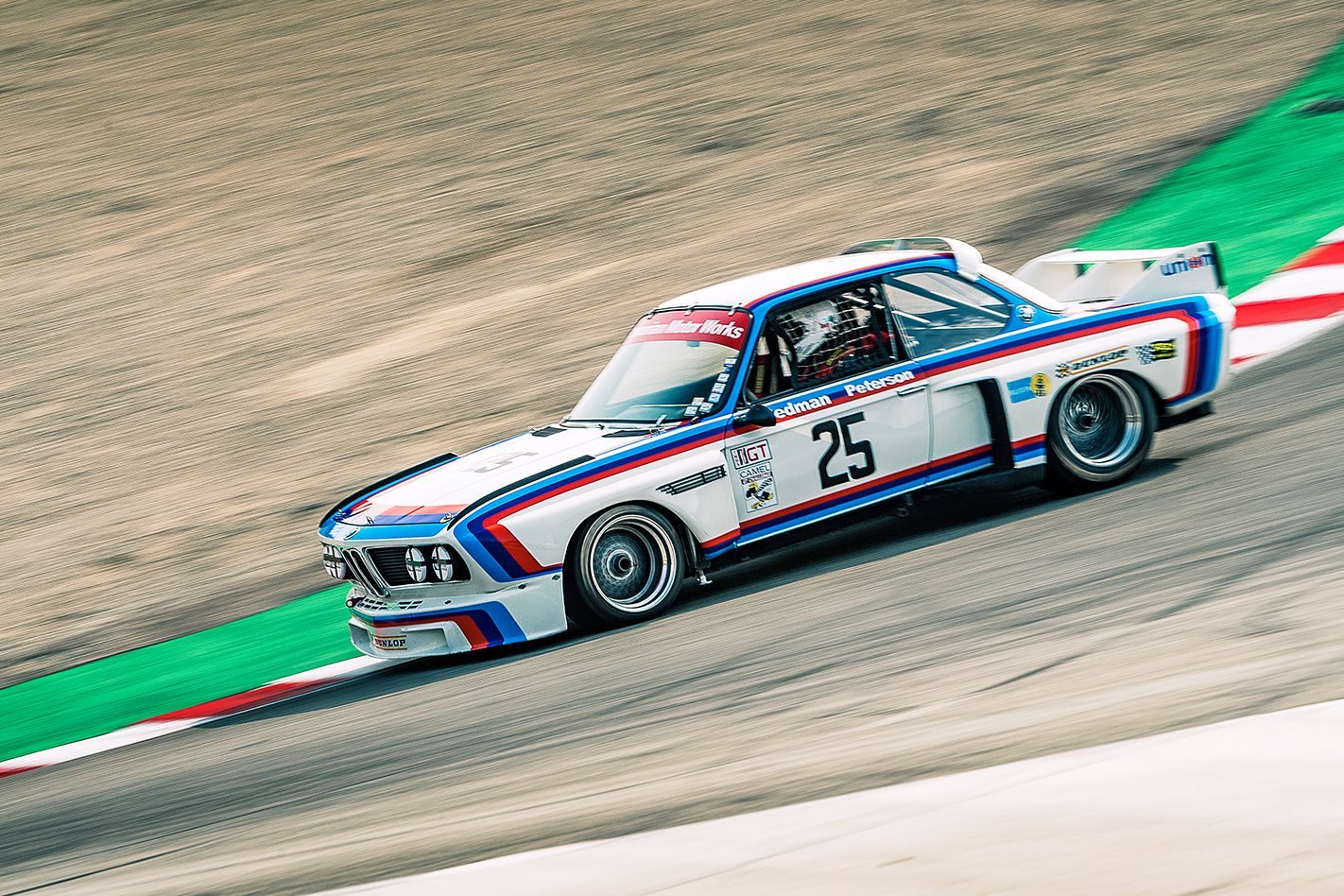THERE is nowhere like Laguna Seca. First, you are in California. A pile of contradictions: desert and verdant, rich and poor, large and empty or small and crowded, depending on where you look. Laguna itself lives in a dry lake atop a scrub-covered mountain, perched in the hills of Monterey county, 190km south of San Francisco. On a clear day, the place feels like a sandy snow globe, the ocean shimmering in the distance.
And in the middle, there is tarmac.
Laguna is a microcosm of California’s variance: alternately fast and slow, pretty and ugly, forgiving and not. So naturally, when I go there to race a 320kW 1975 Group 4 BMW 3.0 CSL works car, at the 2018 running of the Monterey Rolex Motorsports Reunion, America’s most prestigious historic race weekend, a team miscommunication sees me gridded on fresh front slicks but rear tyres nearly dead.
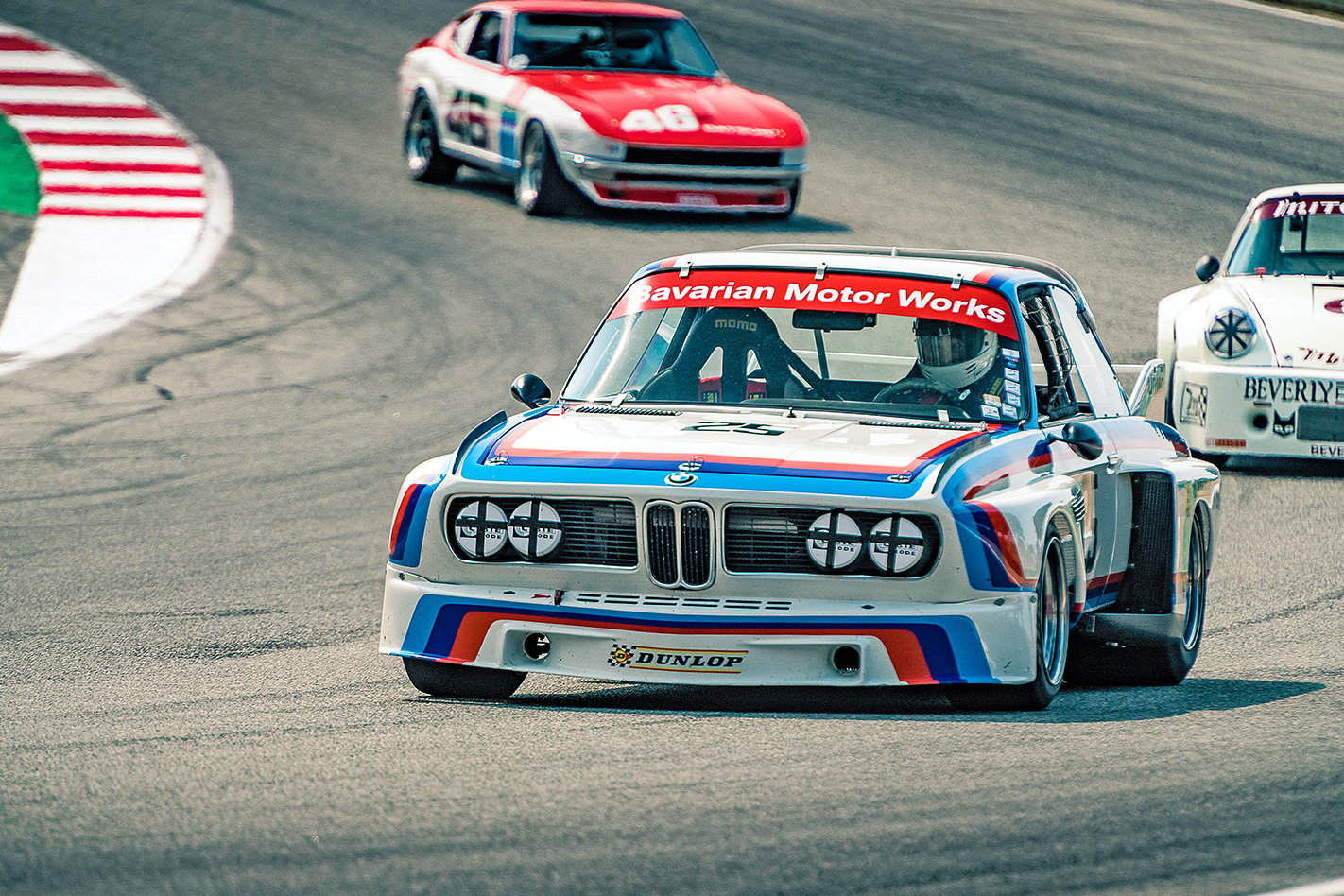
More duality: you’d think this would be terrible. It is not.
The CSL is owned by BMW of North America. The Reunion is part exhibition, a BMW employee tells me. Be safe, he says, and mind the car’s value, but if you can, put on a show.
So I sit on the false grid before qualifying and look around the cockpit. Long wheelbase, miles of belt-line, seat mounted so high I can see the next county. A lap of feel-out shows the car to be friendly, so I drive it for sideshow grins. Bags of throttle, tidy hands, early corners and long, slidey apexes. It’s dramatic and glorious and loud as a bomb, opera on the hoof. I figure lap times will be large and embarrassing, but the car is absurdly forgiving, and CSLs look great in a slide, and I’m not taking even a hint of a risk with it, so hey, I think, why not?
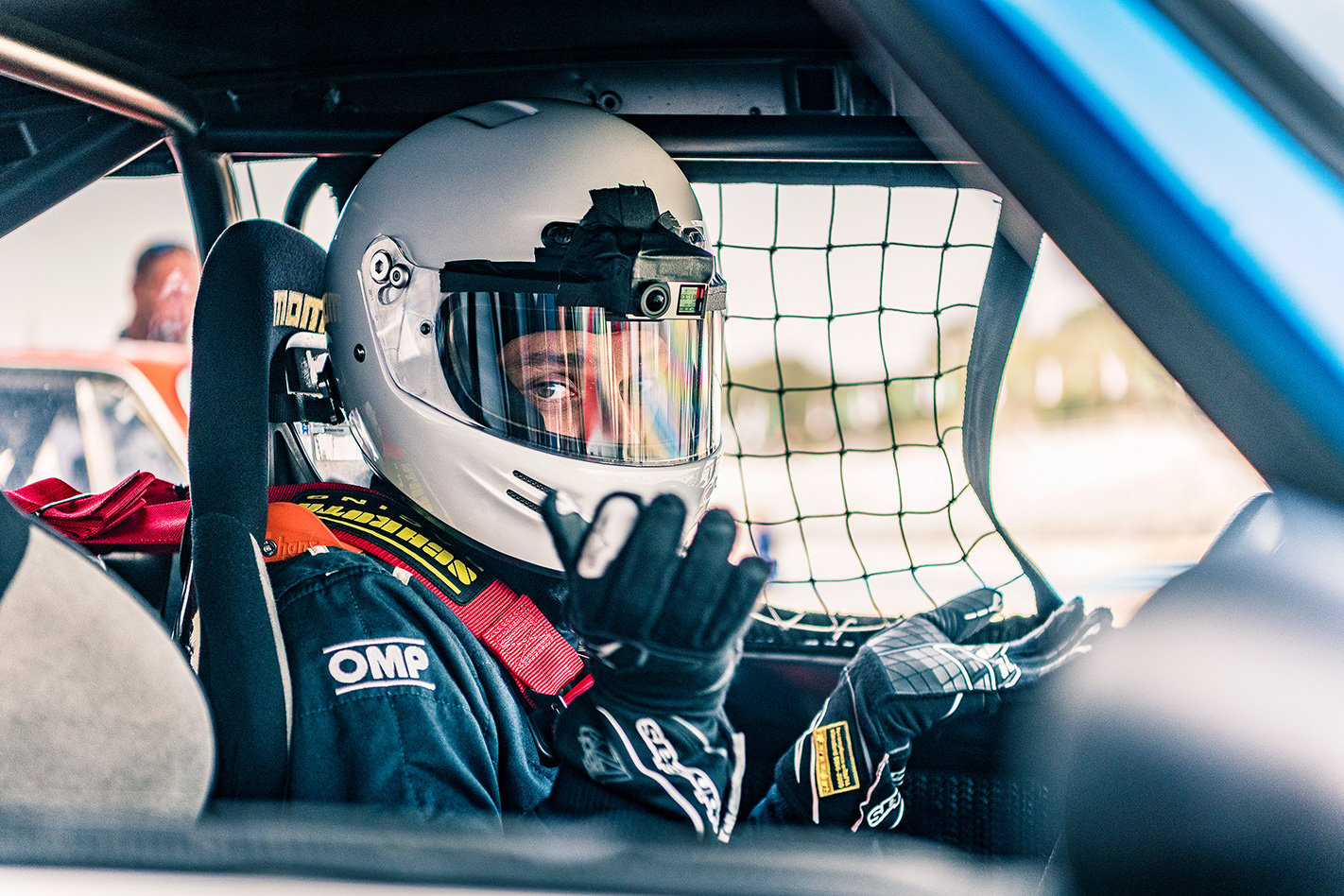
Thirty minutes later, someone hands me the times. The BMW is gridded sixth overall. Fastest of the non-turbo cars in the Reunion’s 50-car IMSA race group, behind four 935s and a Dekon Monza. It turns out that a Group 4 CSL doesn’t really mind losing rear grip, because you can’t miss what you didn’t have much of to begin with. CSL tubs, noticeably flexy, were built by Karmann, a company whose ’70s attention to detail mirrored that of a herd of cats. The springs seem to have been borrowed from a particularly chipper mattress. Goofy fun, glacially slow steering, chassis a bit compromised but not so much as to get in the way, plus a bonkers engine; old BMW writ large.
Which fits. The 1972-’75 3.0 CSL was the first machine to be developed under BMW’s Motorsport GmbH M subsidiary. The name stood for Coupe Sport Leicht and signified a lightweight, aluminium-lidded version of the 1968-1975 CS (E9) coupe. Spec varied with option, market and year, but in peak form the cars got reduced trim and plexi windows, around 200kg of diet under a regular 3.0 CS, and a homologation package that included a roof spoiler and a sweeping, buttressed rear wing in the boot, to be fitted at a later date. Some inspired race fan or journalist dubbed them Batmobiles, and the name stuck.
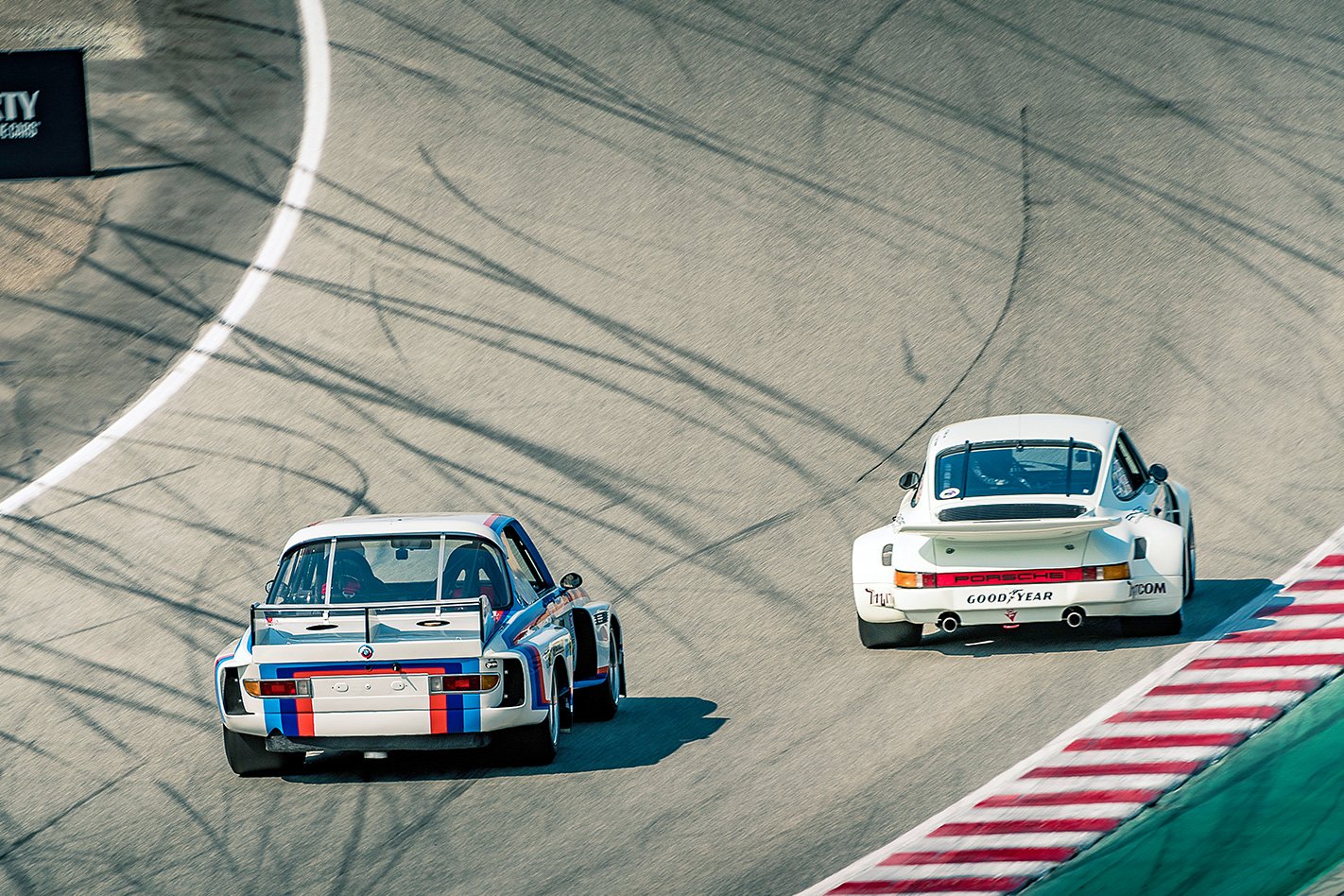
Applied to FIA touring-car racing, this weapon helped build a dynasty. Racing CSLs were 1970s motorsport in flagrante: enormous flares, fat tyres, aerodynamic bits of limited effectiveness but aesthetic genius. Power came from a version of the road car’s single-cam M30 straight-six: 250kW initially, then 320kW in late works trim. Early reliability troubles – chiefly broken crankshafts above 7000rpm – gave way to a rock-solid, 9000rpm configuration sporting twin cams and four valves, plus exotic alloys, a slide throttle and 3.5 litres of displacement. It sounded like fire and was brutally effective. In American IMSA competition, CSLs won overall at the 12 Hours of Sebring and the 24 Hours of Daytona. Across the Atlantic, they landed the 1973 European Touring Car Championship and a class victory at Le Mans the same year, plus every ETCC title from 1975 to 1979.
Five decades on, the showroom E9 remains a lithe style icon. The Leicht comp car is an inarguable peak in BMW firmament, the marque’s 2.7 RS or 250 GTO, and early proof that Munich engineering was among the best in the world. And no big BMW two-door since has made as much of a dent in the culture. Not that they haven’t tried.
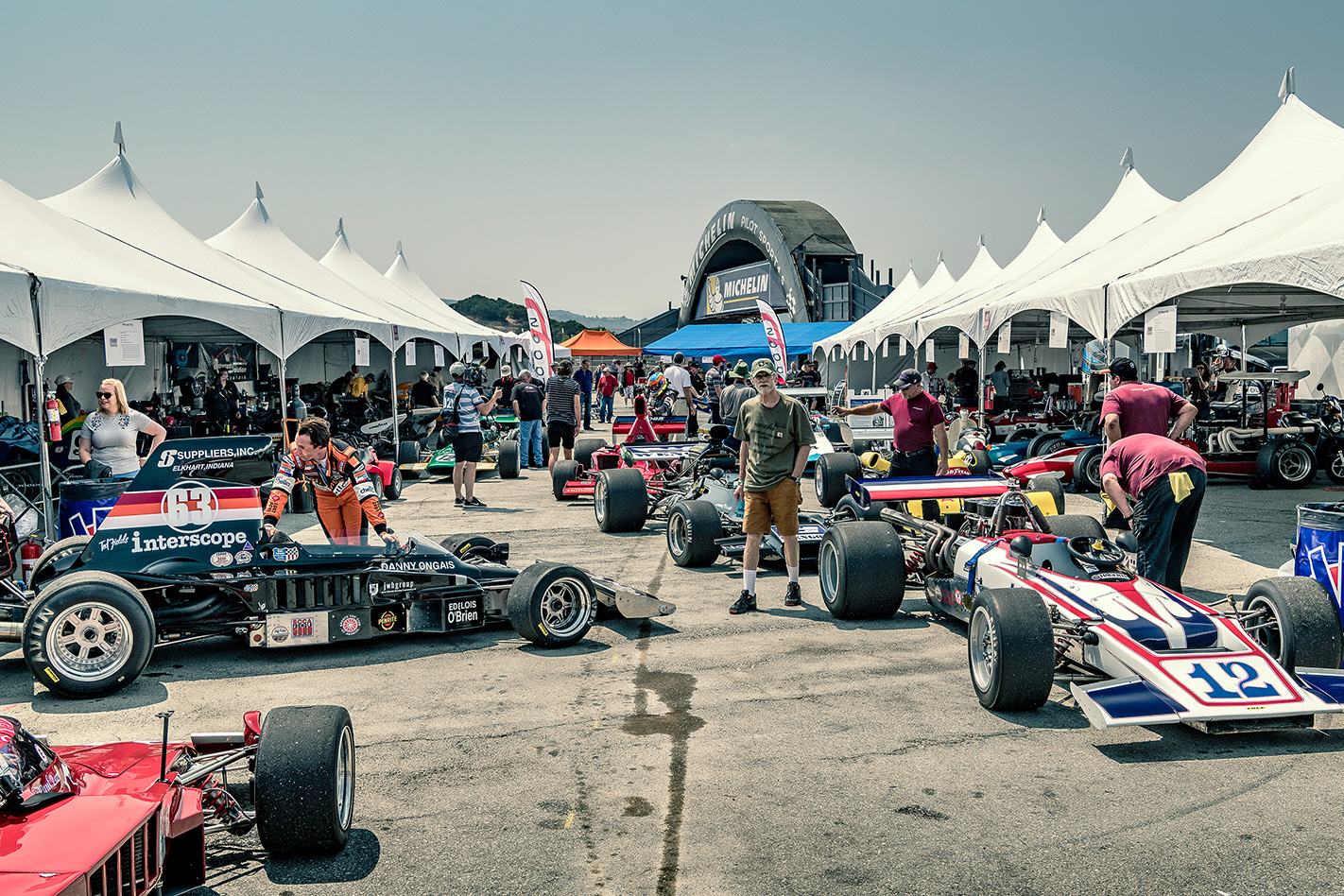
Legend-following is rarely easy. The E9’s successor, the 1976-1989 6 Series, wasn’t a racing landmark but was nevertheless applauded. It was elegant, it sold well and it retains a large following. Less so BMW’s next big coupe, the tech-heavy E31 8 Series. That machine was divisive even among loyalists – the BMW Car Club of America’s glossy print monthly, Roundel, panned the thing. (If the E31 was intended to be ‘a crown jewel,’ the editor later wrote, ‘then it’s cubic zirconium’.)
BMW subsequently built two generations of two-door range-toppers. Both were badged 6 Series, and neither was that memorable. It’s enough to make you wonder if the marque’s modern engineering verve is simply limited to a handful of blueprints. Which is why I’m also driving a 2019 M850i xDrive development car on Monterey blacktop, albeit highway tarmac. According to BMW, the car’s largely representative of the finished article, if awaiting final calibration. The truth is that big coupes no longer sell in big numbers but they still matter for brand image, and I’m curious whether the new car mirrors the old one’s soul.
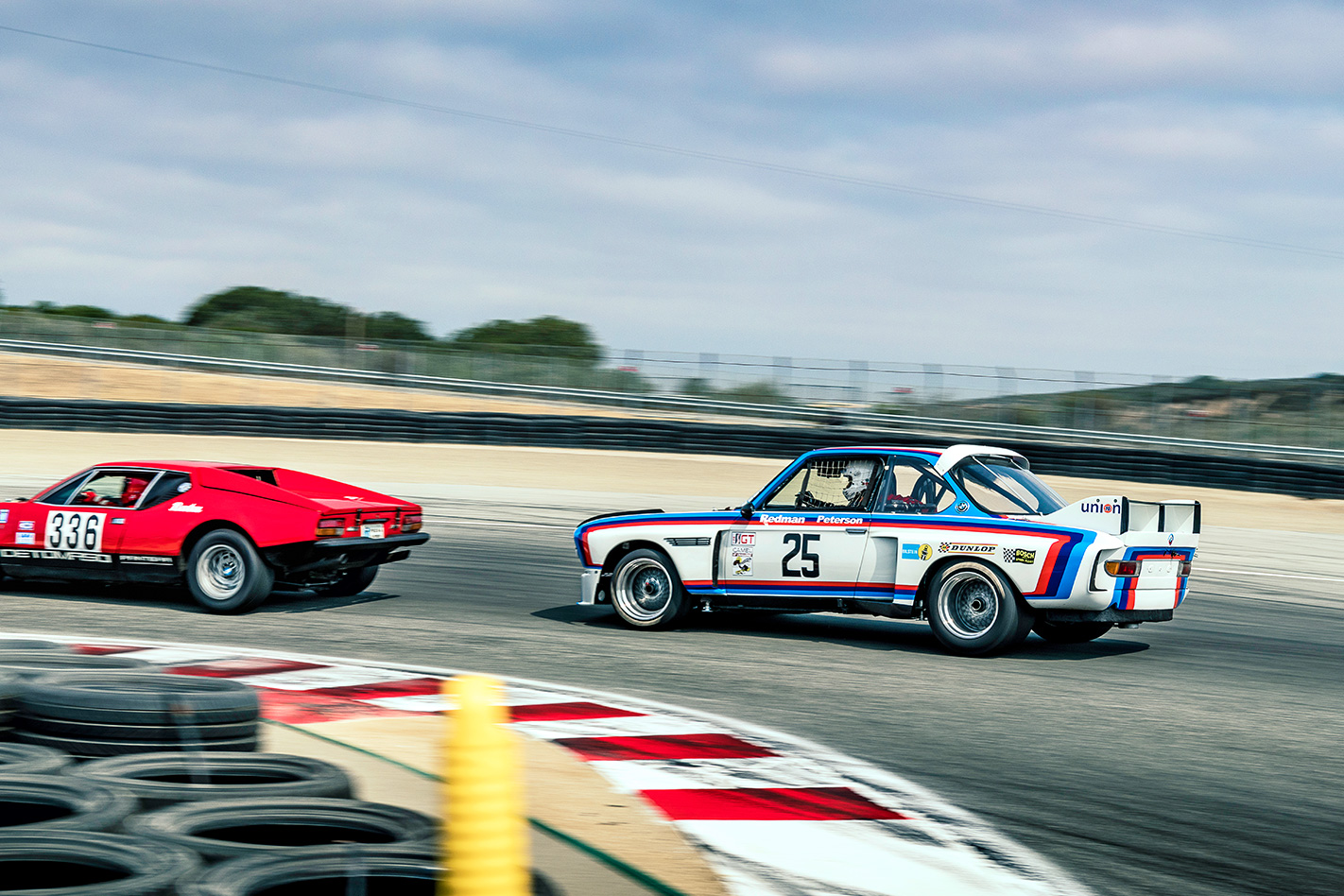
The 2019 8 Series debuted as a concept in 2017, at the Villa d’Este concours. The production car is less elegant, the same rear-drive silhouette plus a few styling fillips. Few of those appear necessary or functional, though a design team in Germany would undoubtedly tell you otherwise. In M850i form, with BMW’s xDrive all-wheel drive – Australia will get this model, and the rear-drive, six-cylinder 840i in March – the car can look oddly disjointed from certain angles. You see Ford Mustang and Aston Martin in the rear quarters, E31 in the trunk, Lexus in the front. A thousand other coupes in those silly front-guard vents.
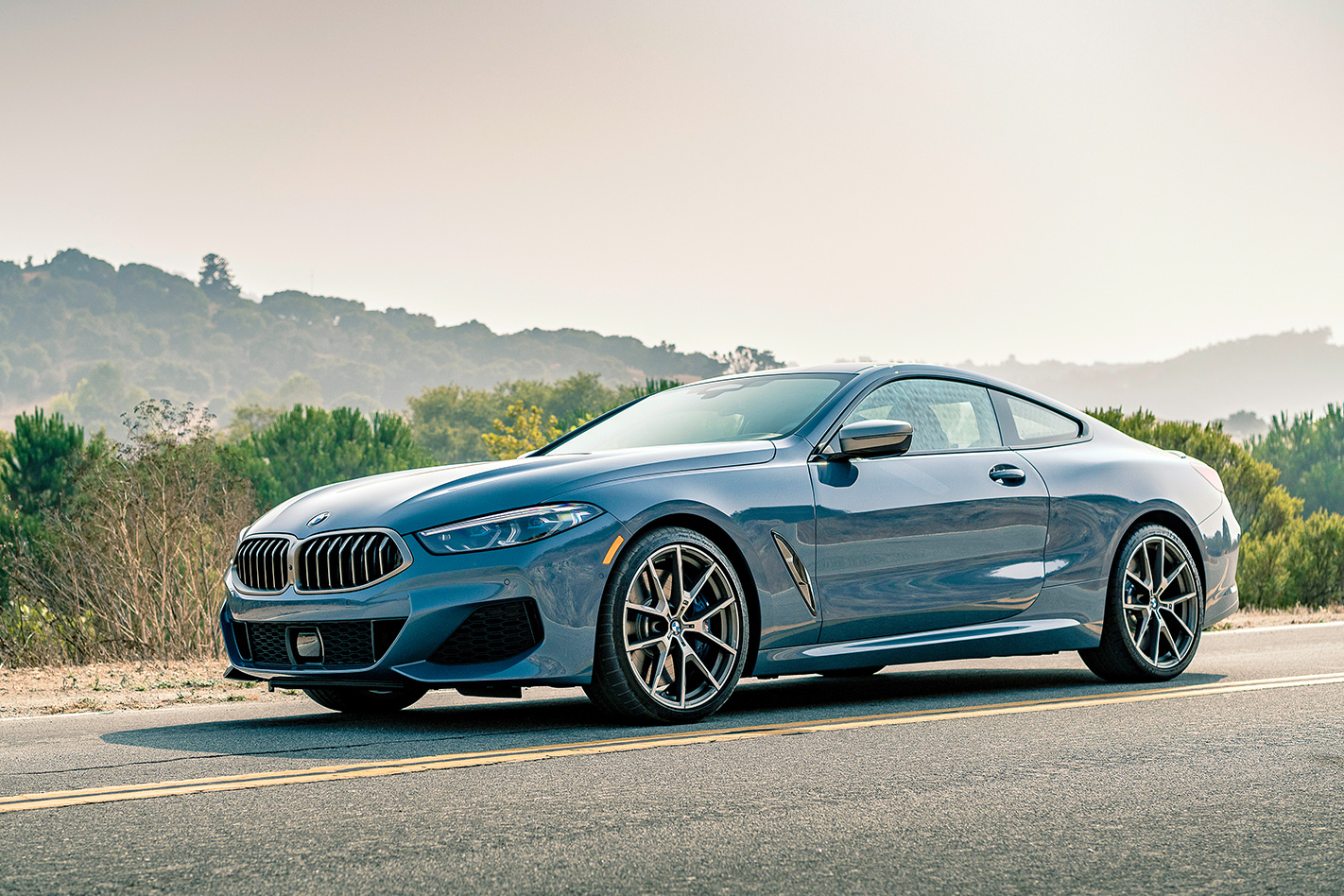
The proportions are fitting, however, because the 8’s centre differential was designed to behave like the one in the current M5: all grunt to the rear wheels, all the time, unless traction gets hinky. Power comes from a twin-turbo, 4.4-litre V8 good for 390kW and 750Nm. The engine is a heavy rework of the reverse-flow 4.4 in the outgoing 650i, with larger turbos between its cylinder banks, plus other updates like a new crank and pistons.
It is, predictably, a honker. Peak torque wallops in at 1800rpm and sticks around until 4600rpm. It translates into all the shove you could ever want on a B-road, which is nice, because the chassis actually works in tight confines. So on a weekday afternoon, I weave down to Monterey’s Carmel Valley Road, a quiet gem in a region chock with amazing pavement.
CVR heads east from the ocean, four lanes and a dividing median, past a few shopping centres and petrol stations, before necking down into a two-lane. The valley narrows a bit, past farms and a few small wineries. Shortly after, the road dives into a run of narrow canyons, tunnelling under oaks and eucalyptus. The lane markings disappear, along with the oncoming lane, and then the road climbs again, popping out of the trees to crest golden ridges. It ends to the south-west, in flat commercial farmland. The whole run takes just over an hour if you’re hustling and is mostly empty during the week.
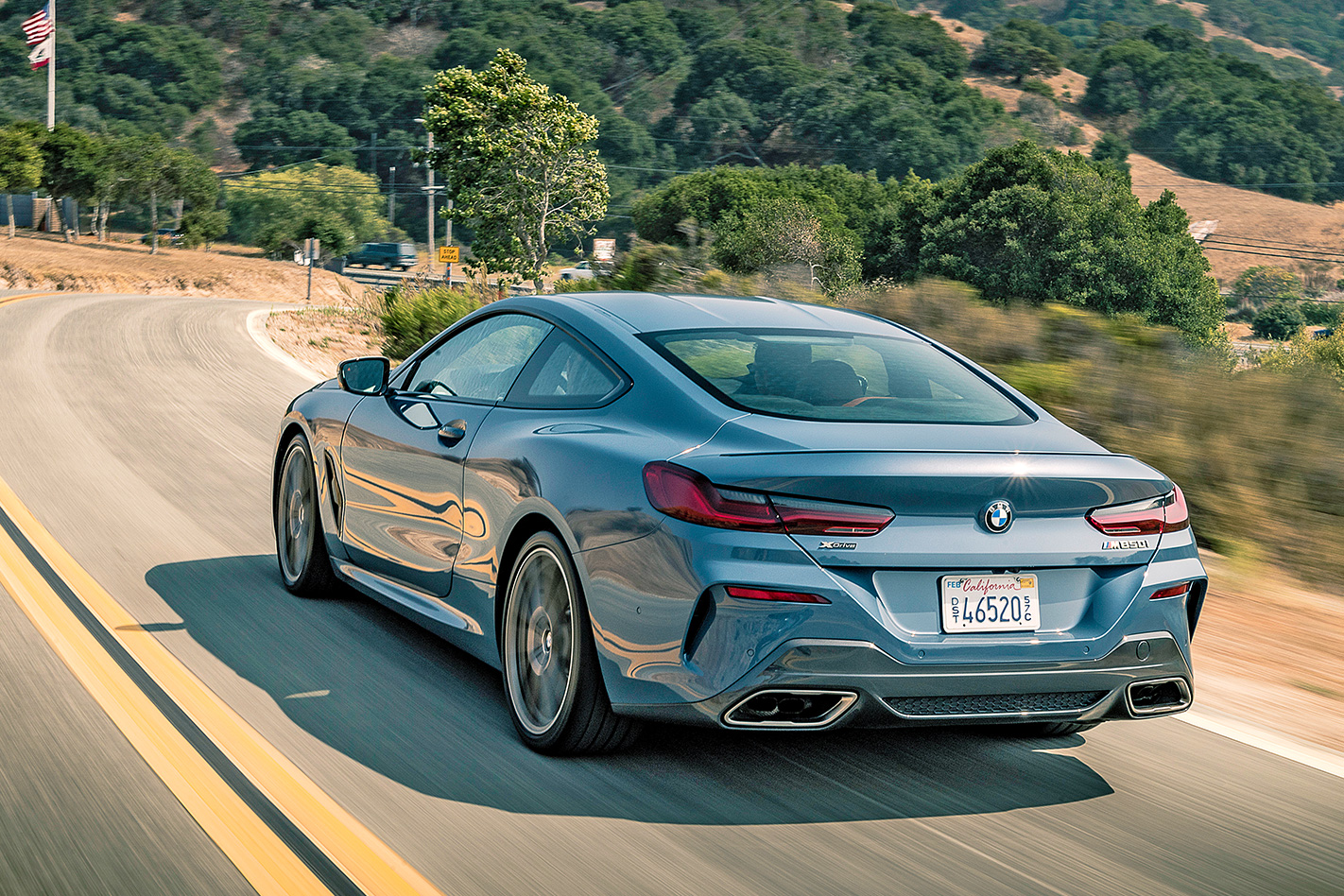
A landscape like this can make an E9 or most modern GT cars feel long of foot. The 8 Series feels smaller than it should, oddly at home. Partly because our test car is equipped with rear-wheel steering and the optional active anti-roll bars. And partly because it reacts quickly to mid-corner changes without beating my kidneys to pieces.
The tuning philosophy is a sea change – unlike most sporting BMWs of the last 10 years, the M850i errs on the side of usable suspension travel and moderate damper rebound, regardless of chassis mode. (Four are available: Eco Pro, Comfort, Sport and Sport Plus.) In Sport Plus, the active anti-roll bars will stiffen the rear on turn-in, helping the car pivot into a corner before releasing. At anything short of a murderous pace, the 8 feels entirely rear-drive, more interested in the rear tyres than the fronts. The electronically locking diff, the all-wheel-drive system’s torque-vectoring abilities; when you’re not cranking, it all goes soft-focus in the background. Even the gearbox, ZF’s excellent eight-speed automatic, does a decent impression, in Sport Plus, of the gear-guessing in Porsche’s amazing PDK dual-clutch. Braking or a lift can trigger a snap downshift, and gears are held when you want. It might be the best tune of the best traditional automatic on the planet.
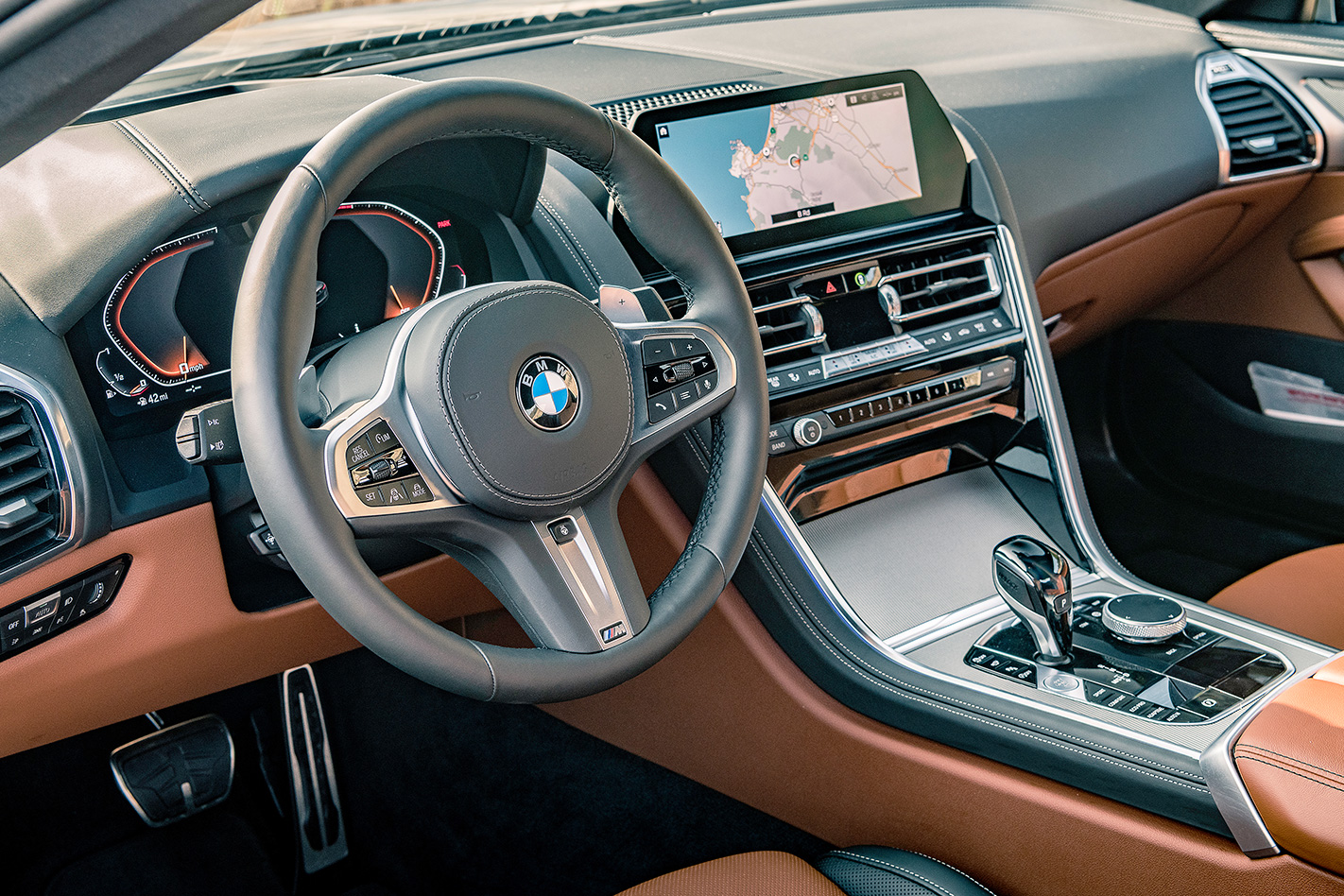
As I drive, my head circles around why a person buys a fast coupe with a huge footprint. And what might make a car like that feel special. By way of illustration, consider this: at a claimed 1890kg, partly thanks to clever touches like a carbonfibre transmission tunnel, the all-wheel-drive 8 is around 200kg lighter than its most obvious foil, the Mercedes-Benz S560 4Matic coupe. The Mercedes looks more liquid, but the BMW makes more power and torque. The 8 is less obviously elegant and lacks the Benz’s ravishing interior, but it feels sparkier on a back road.
Which of these qualities are critical for a large GT car is a separate discussion, but either way, one of these cars seems sure of what it needs to be, and the other seems the product of a company trying to rectify its past with what it wants to be next.
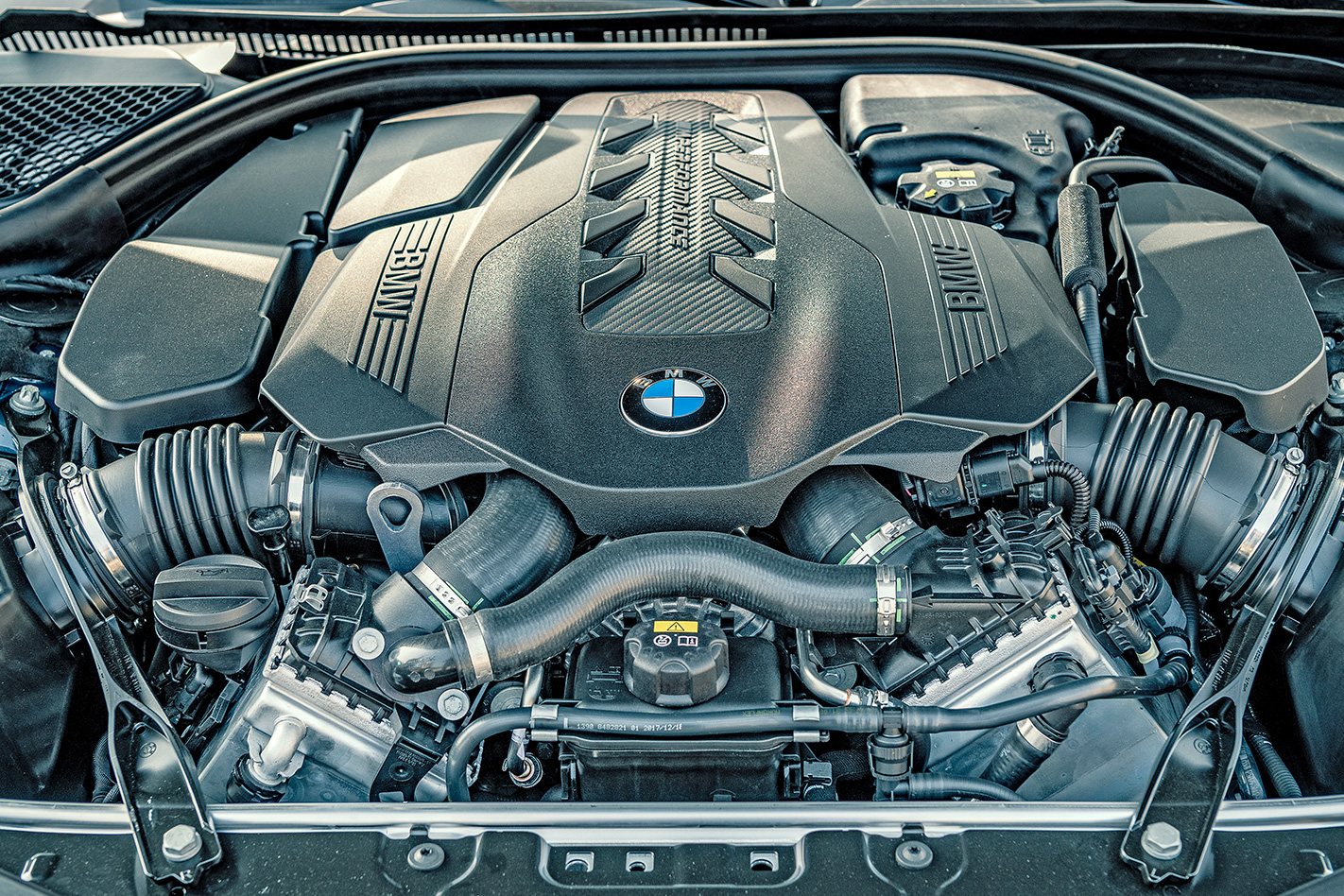
Our development tester, still a work in progress, offers a few glaring drawbacks: greasily numb steering no matter the chassis setting, plus a brake pedal grabby at the top of its travel. The engine sounds like nothing in particular, anonymous V8 gurgle, even in the chassis modes where the exhaust bypass valves are open and the stereo plays a synthesised, engine-ish noise. For the record, the latter practice is ferociously lame. Just because car makers keep on doing it does not make it any less lame, especially given that the majority of the world now views authenticity as fashionable.
The rest, however, is food for thought. It makes me think about what makes up the personality of a marque. And it reminds me of the current M5, in that it hints at how BMWs haven’t behaved in far too long.
“THEY were squishy,” race driver Sam Posey told me, over the phone. “Really designed to be driven by Hans Stuck. He initiated slides well before the turn – you could just about read the writing on the side of the car, he was so far out of shape. It was really something.”
There are worse philosophies around which to tune a ’70s racing weapon. Months before my trip to Monterey, I rang Posey to ask about the CSL. An American driver and broadcaster, he raced the cars, in period, for BMW of North America. As did Hans Stuck, Brian Redman and Ronnie Peterson, among others.
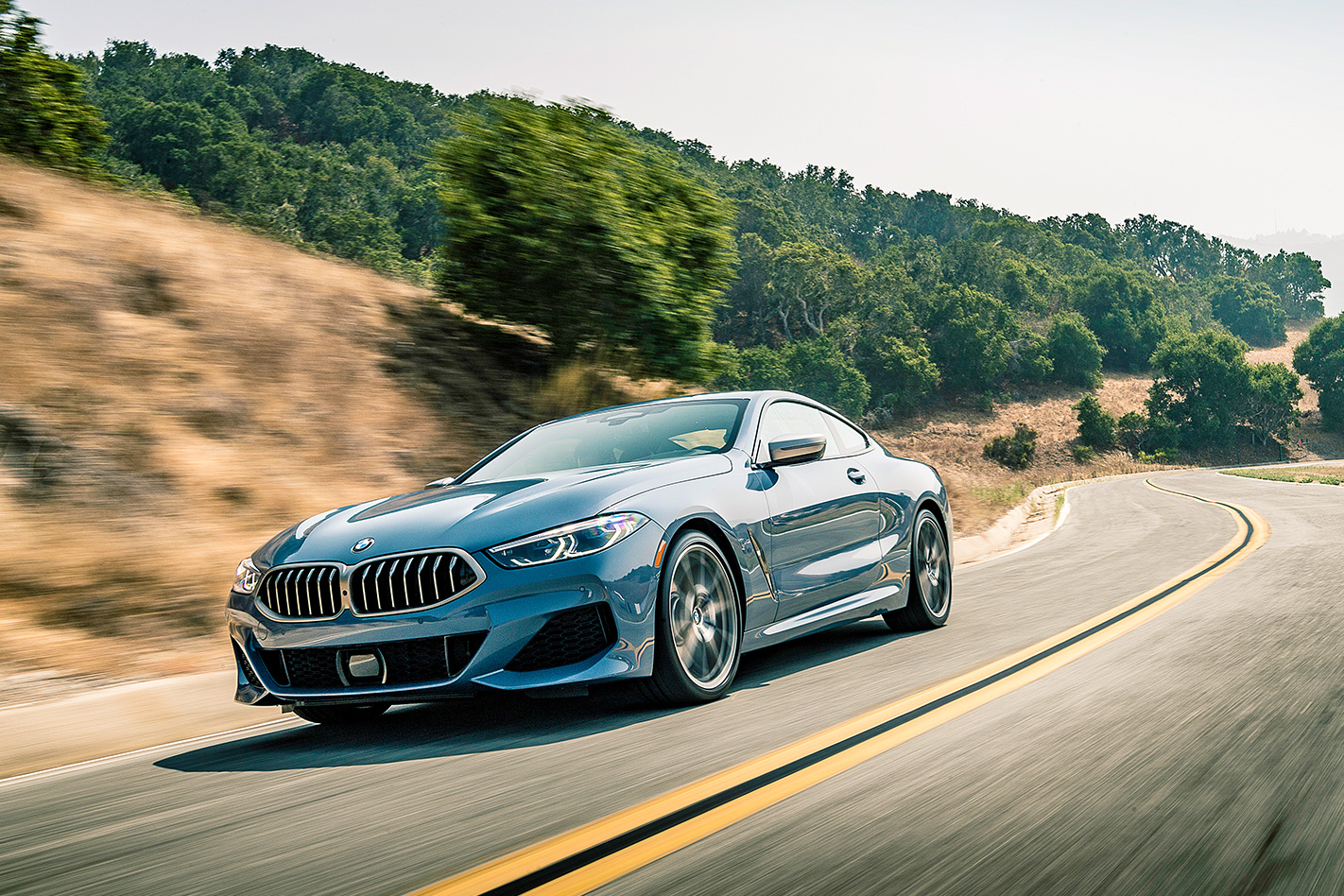
Redman once told me that the pillarless CSL was ‘a big wiggly piece of steel with a hole in the middle’.
His eyes twinkled and then he winked, allowing that he loved the car.
I think of his words at the start of my first race at Laguna, looking at the spindly period rollcage. I’m in chassis #2275985 – the last of five IMSA works examples. One of its four sisters later became BMW’s Alexander Calder Art Car. Nine-eight-five has a dog-leg five-speed and 16-inch-wide rear slicks. Redman and Posey both drove this chassis, as did Stuck. Like all E9s and most BMWs before the early ’90s, it uses struts up front and semi-trailing arms in the rear.
The engine, a rare four-valve M49, is rev-limited to 8000rpm for longevity. It shrieks at idle but bellows under load, a raspy tenor that fire-hoses torque on every shift. I want to be buried in its noise, ripping through the gearbox for the rest of my life.

I run two races. In the first, after starting sixth, the brakes go soft and I fall to eighth, behind a 911 RSR. Each corner takes two early pumps of the pedal but it never feels dicey, and the car always stops. (Blame a lack of brake ducts; the BMW ran with them in period but somehow arrived at Laguna without.) So I carry on, skating around in a blissful trance, in awe of the romance of the thing, trying to make up what the brakes lose, watching that long white nose vector off the tail lights. I start eighth in the second race, caught in an elastic fight between two other RSRs, and finish seventh.
My results are telling of the car but ultimately immaterial. Historic racing is a modern moment never as important as when its hardware was contemporary; by the same token, contemporary racing perpetually hinges on what happens in the next moment. Which is part of what makes motorsport so interesting.
“BMW was first and foremost an engine-building company,” Posey explained to me. We discussed how a small group of Bavarians were sent across the Atlantic with a handful of CSLs and told to go racing. The Germans called them ‘cowboys’.
“Penske and Ferrari, the other big teams I had driven for – Ferrari was very casual; with NART, hardly a team at all. With BMW, it felt like we were frontiersmen. There were executives holding signs in the pits. They wanted the publicity, to get people to understand that BMW didn’t stand for British Motor Works. They’d taken a survey in the US and found that people thought that, and they were appalled.”
A factory-backed BMW M8 GTE racing car debuted at this year’s Le Mans; I suspect that it’s fairly good. But unlike the CSL, any competition success it sees is unlikely to sway the fate of the company. The world just doesn’t work like that any more, and car makers no longer pivot around noise and speed. The new M850i isn’t perfect but it is a very encouraging sign of life. Maybe the full-house production M8, due next year, will riff on the old CSL’s lessons; evocative and timeless, more than the sum of its parts. The Bavarians went there once – here’s hoping they go there again soon.

